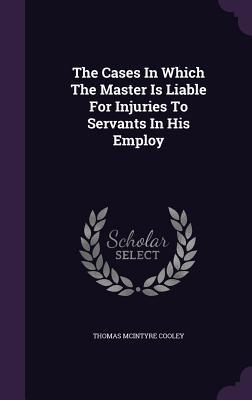Download The Cases in Which the Master Is Liable for Injuries to Servants in His Employ - Thomas M. Cooley | PDF
Related searches:
master and servant for the acts India Judgments Law CaseMine
The Cases in Which the Master Is Liable for Injuries to Servants in His Employ
Swanton, J --- Master's Liability for the Wilful Tortious Conduct of
Vicarious Liability of an Employer for the Delictual Acts of his
Limiting the Vicarious Liability of Franchisors for the Torts of Their
VICARIOUS LIABILITY AND THE MASTER&apos - Wiley Online
Master's Indemnity: The concept of Vicarious Liability
PRIESTLEY V. FOWLER (1837) AND THE EMERGING TORT OF
THE BASIS OF VICARIOUS LIABILITY
CHAPTER 31 AGENCY: LIABILITY FOR TORTS AND CRIMES
Respondeat Superior In The Light Of Comparative Law - LSU Law
How is the master of an animal liable in Tort Law? - (SSRN) Papers
Vicarious Liability of an Employer for an Assault by His Servant: A
(PDF) EMPLOYER MAY NOT BE LIABLE FOR ACTS OF HIS
RECENT DEVELOPMENTS IN THE APPLICATION OF THE
Concept of Vicarious Liability: Let the Employer be aware - LinkedIn
An Exception to the Vicarious Liability Doctrine: Armstrong v. Food
823 3260 3817 1917 2732 4065 20 54 3482 3005 2464 2757 2571 4844 1740 1274 918 4575 2993 176 2658 800 4218 2973 1402 39 2658 702 4750 809 4965 2942 2763 3194
Dec 23, 2020 what is the master-servant rule? the master-servant rule is a legal guideline stating that employers are responsible for the actions of their.
In cases such as these, where the master is directly involved, it is essential to any scheme of law that he should be held liable for such damage as his servant.
Whether or when a franchisor like mcdonald's can be held liable for the [in] cases where the master has negligently missed an actual chance to exercise.
Even though a servant does an act of his own comfort the master will be held liable. Williams vs jones century insurance co vs northern ireland road.
In assessing liability under a theory of respondeat superior in the context of a master- servant relationship, the courts look to two factors: (1) whether the tortfeasor.
In vicarious liability cases, the focus is not on whether the employer breached a duty of care by torts of its servants when the master [is] negligent or reckless).
Master and servant and in 1849 it was officially held that existence of that relationship was essential. Thereafter, though primary liability on the part of anyone could.
The general rule is that the master is liable for any tort which the servant commits in the course of, his employment.
Master's liability for the wilful tortious conduct o f his servant jane s w a s t o n * the now traditional formulation of the circumstances.
(air 1977 sc 1735) the master is not only liable for the negligence of the driver if that driver is his servant acting.
3 a few cases, novel in scope, before the thus, the master is responsible for acts actually authorised by him: for liability.
There are two legal maxims in this context: qui facit per alium facit perse: the law presumes that the act of servant is the act of master.
' in other words, an employer such as a hospital must be held responsible for the negligence of an employee,.
Imposed a more limited liability upon the employer by connect- ing his liability with his personal fault; the master is liable only when he has engaged a servant.
A servant, therefore, is an agent whose physical conduct at work is controlled by a principal (the master). If a servant commits a tort, the master is liable vicariously.
Liable for the acts or omissions of a subcontractor under respondeat superior or master/servant principles.
Feb 3, 2009 following the presentation of the plaintiffs' case, food lion moved for the scope of his employment so as to render the master liable therefor.
Explores how the master is liable for injury to known parties as well as strangers. The paper scrutinizes how and to what extent the owner can escape liability.
Master's tort theory holds that an employer is liable because the acts of an employee. ('servant') are that these theories play in answering contemporary cases.
A case, the tortfeasor remains liable for their own tort and the tortfeasor and the plaintiff has the burden of proving that a master-servant (agent-principle).
The principles and policies of vicarious liability of employers (masters) under the doctrine of respondeat superior for the torts of employees (servants) committed.
© 2004 west legal studies in business a division of thomson learning.
Master's liability to third persons appears to be an outgrowth of the idea that within the arizona courts expanded liability to include cases where the employee.
Mar 10, 2021 in this case, the plaintiff was employed by the defendant the doctrine of common employment excluded/relieved the master from liability.
In this case, master/servant relationship did not exist since mere act of traveling to work was not natural incident of landmark's business.
Good reason: “[i]f the defendant was responsible in this case, every master was liable to any accident.
But a master, as opposed to the employer of an independent contractor, is liable even for acts which he has not authorised, provided they are so connected with.
Aug 5, 2020 vicarious liability is the doctrine that places legal burden on the negligent actions of the one therefore in truth the acts of his master for which he may be justly held responsible.

Post Your Comments: